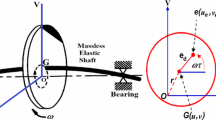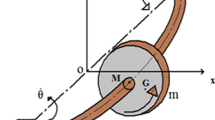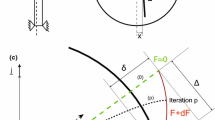Abstract
Both the rotationally asymmetric inertia and transverse crack frequently appear in the rotor system. The parametric excitations induced by this two features cause instability and severe vibration under certain operating conditions. Thus, the parametric instability of a Jeffcott rotor with asymmetric disk and open transverse crack is studied analytically. The vibration equations of four degrees-of-freedom of the system are established, and the stiffness coefficients of cracked rotor shaft are derived based upon the compliance method and strain energy release rate method. Then, utilizing the harmonic balance method and Taylor expansion technique, the unstable widths of simple and combination instability regions (SIR and CIR) are solved approximately. For a practical rotor system, the approximate unstable widths are verified by the Floquet numerical analysis. The effects of crack depth and position upon the unstable widths are discussed, and the conditions for zero unstable points (ZUPs) are given: Besides the asymmetric angle should be π/2 (for SIR) or 0 (for CIR), the relationships between the inertia asymmetry and crack parameters (depth and position) are also presented analytically. These results would be useful for crack detection and instability control of the asymmetric rotor-bearing system.









Similar content being viewed by others
References
Crandall, S.H., Brosens, P.J.: On the stability of rotation of a rotor with rotationally unsymmetric inertia and stiffness properties. J. Appl. Mech. 83, 567–570 (1961)
Yamamoto, T., Ota, H.: On the unstable vibrations of a shaft carrying an unsymmetrical rotor. J. Appl. Mech. 86, 515–522 (1964)
Yamamoto, T., Ota, H.: The damping effect on unstable whirlings of a shaft carrying an unsymmetrical rotor. Mem. Fac. Eng., Nagoya Univ. 19, 197–215 (1967)
Ardayfio, D., Frohrib, D.A.: Instabilities of an asymmetric rotor with asymmetric shaft mounted on symmetric elastic supports. J. Eng. Ind. 98, 1161–1165 (1976)
Genta, G.: Whirling of unsymmetrical rotors: a finite element approach based on complex co-ordinates. J. Sound Vib. 124, 27–53 (1988)
Kang, Y., Shih, Y.P., Lee, A.C.: Investigation on the steady-state responses of asymmetric rotors. J. Vib. Acoust. 114, 194–208 (1992)
Kang, Y., Lee, Y.G.: Influence of bearing damping on instability of asymmetric shafts, part III: disk effects. Int. J. Mech. Sci. 39, 1055–1065 (1997)
Takashi, I., Murakami, S.: Dynamic response and stability of a rotating asymmetric shaft mounted on a flexible base. Nonlinear Dyn. 20, 1–19 (1999)
Nriot, N., Lamarque, C.H., Berlioz, A.: Dynamics of a rotor subjected to a base translational motion and an uncertain parametric excitation. In: 12th IFToMM World Congress, Bezanson, France (2007)
Ishida, Y., Liu, J.: Elimination of unstable ranges of rotors utilizing discontinuous spring characteristics: an asymmetrical shaft system, an asymmetrical rotor system, and a rotor system with liquid. J. Vib. Acoust. 132, 011011 (2010)
Hsieh, S.C., Chen, J.H., Lee, A.C.: A modified transfer matrix method for the coupled lateral and torsional vibration of asymmetric rotor-bearing systems. J. Sound Vib. 312, 563–571 (2008)
Meng, G., Gasch, R.: Stability and stability degree of a cracked flexible rotor supported on journal bearings. J. Vib. Acoust. 122, 116–125 (2000)
Gasch, R.: Dynamic behaviour of the Laval rotor with a transverse crack. Mech. Syst. Signal Process. 22, 790–804 (2008)
Fu, Y.M., Zheng, Y.F., Hou, Z.K.: Analysis of non-linear dynamic stability for a rotating shaft-disk with a transverse crack. J. Sound Vib. 257, 713–731 (2002)
Chen, C.P., Dai, L.M.: Bifurcation and chaotic response of a cracked rotor system with viscoelastic supports. Nonlinear Dyn. 50, 483–509 (2007)
Chen, C.P., Dai, L.M., Fu, Y.M.: Nonlinear response and dynamic stability of a cracked rotor. Commun. Nonlinear Sci. Numer. Simul. 12, 1023–1037 (2007)
Sekhar, A.S., Dey, J.K.: Effects of cracks on rotor system instability. Mech. Mach. Theory 35, 1657–1674 (2000)
Sinou, J.: Effects of a crack on the stability of a non-linear rotor system. Int. J. Non-Linear Mech. 42, 959–972 (2007)
Ricci, R., Pennacchi, P.: Stability analysis of a cracked rotor with several degrees of freedom. In: Proceedings of the ASME 2009 International Design Engineering Technical Conferences & Computers and Information in Engineering Conference, San Diego, USA, DETC2009-86764 (2009)
Han, D.J.: Vibration analysis of periodically time-varying rotor system with transverse crack. Mech. Syst. Signal Process. 21, 2857–2879 (2007)
Han, Q.K., Chu, F.L.: The effect of transverse crack upon parametric instability of a rotor-bearing system with an asymmetric disk. Commun. Nonlinear Sci. Numer. Simul. 17, 5189–5200 (2012)
Huang, C.J.: A study on dynamic characteristics of geared rotor-bearing system with crack. Ph.D. Dissertation, National Cheng Kung University, Taiwan (2003)
Papadopoulos, C.A., Dimarogonas, A.D.: Coupled longitudinal and bending vibrations of a rotating shaft with an open crack. J. Sound Vib. 117, 81–93 (1987)
Nayfeh, A.H., Mook, D.T.: Nonlinear Oscillations. Wiley, New York (1979)
Acknowledgements
The research work described in the paper was supported by the National Science Foundation of China under Grant Nos. 51075224 and 11102095. The authors would also express sincere thanks for the support from the National Science Foundation for Distinguished Young Scholars (No. 11125209).
Author information
Authors and Affiliations
Corresponding author
Appendix: Numerical determination of unstable regions based upon the Floquet theory
Appendix: Numerical determination of unstable regions based upon the Floquet theory
By taking \(\mathbf{y}(t)=[\dot{\mathbf{q}}(t)\ \mathbf{q}(t)]^{T}\), Eq. (11) could be transformed into the state space as
in which the coefficient matrices A(t) and B(t) are expressed as


where



The classical method to study the parametric stability uses the Floquet theory. To avoid the additional time domain processing and to keep the inherent advantages of the frequency method (low computational cost and speed compared with the direct integration), it is recommended to use a frequency method for the determination of the stability. According to the Floquet theory, a solution of Eq. (33) can be written as a product of an exponential part and 2π/(2Ω)=π/Ω periodic part. Representing the periodic part by its complex Fourier series expansion, this solution can be written as
where \(\textrm{i}=\sqrt{-1}\), ρ represents the Floquet (or characteristic) exponent and y k are the complex Fourier coefficients’ vectors. Considering the coefficient matrices A(t) and B(t) are periodic with single harmonic frequency 2Ω, thus they could be rewritten by finite complex Fourier series


Substituting Eqs. (37)–(39) into Eq. (33), and simplifying by setting the same harmonic coefficients zero, then one can obtain the following infinite-dimensional eigenvalue problems about ρ as
in which
and


where \(\boldsymbol{\varLambda}^{(0)}_{k}=-\mathbf{B}_{0}+\textrm{i}2k\varOmega \mathbf{A}_{0}\), \(\boldsymbol{\varLambda}^{(1)}_{k}=-\mathbf{B}_{-2} + \textrm{i}2k\varOmega\mathbf{A}_{-2}\) and \(\boldsymbol{\varLambda}^{(2)}_{k}=- \mathbf{B}_{2}+\textrm{i}2k\varOmega\mathbf{A}_{2}\) (k=…,−1,0,1,…). In order to get approximate numerical eigenvalues for the stability analysis, Eq. (40) should be truncated into a finite-dimensional one. In practice, the first few harmonics are needed to meet the precision requirements. The eigenvalues of Eq. (40) are complex. If the system is stable, the real part of all eigenvalues ρ is negative and the exponential part diminishes as the time passes. On the other hand, if at least one of the eigenvalues has a positive part, the system is unstable.
Rights and permissions
About this article
Cite this article
Han, Q., Chu, F. Parametric instability of a Jeffcott rotor with rotationally asymmetric inertia and transverse crack. Nonlinear Dyn 73, 827–842 (2013). https://doi.org/10.1007/s11071-013-0835-6
Received:
Accepted:
Published:
Issue Date:
DOI: https://doi.org/10.1007/s11071-013-0835-6




